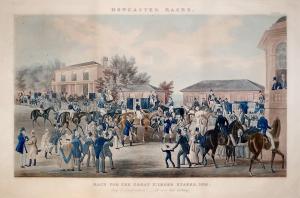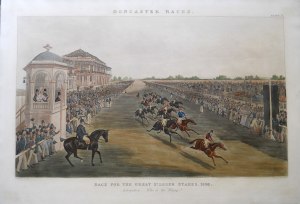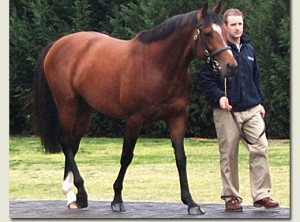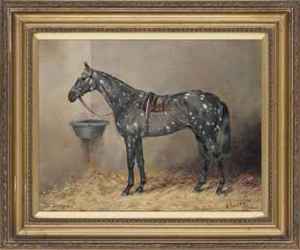It is the oldest classic race in England and, arguably, the most prestigious.


The English St Leger Stakes is the classic that marks the end of the British flat racing season and its prestige is such that a “St. Leger copy” has been woven into racing calendars in Ireland, Jamaica, Australia and the United States. This classic takes place in Doncaster, Yorkshire, a large town that was initially settled on the site of a Roman fort, Danum, in the first century B.C., maturing into a busy town by the 13th century. Near enough to larger cities to make travel there feasible by horse, Doncaster was (and remains) a market, or “mercat” town, with a thriving commerce designated, like all such towns in England, by its market cross. From about the 15th century, Doncaster was known as a prosperous area, populated by the wealthy who lived in estates like Cantley Hall and Brodsworth Hall.

The market cross, designating Doncaster as a market town where goods of all kinds and livestock were sold for centuries, stands to this day on the site of the original market.

Doncaster market in 1906.

Doncaster market today.
Doncaster is one of the oldest centres for horse racing in Britain, with records of regular race meetings going back to the 16th century. In 1600 there was an attempt to put an end to the races because of the number of ruffians they attracted, but by 1614 failure to do so was acknowledged and a proper racecourse was duly marked out. The Doncaster Cup, the city’s oldest classic race, was first run on Cantley Common in 1766; by 1776, the Doncaster racecourse as we know it today was set up in its permanent home, the Town Moor.

Doncaster racecourse as it looked in the 18th century.

Doncaster racecourse circa 1900…

…and today.
The original St. Leger kicked off in 1776 and, with only one exception, has run annually in September ever since.
This year, the field for the 2016 St. Leger is dominated by Coolmore-Ballydoyle’s colt, Idaho, although it won’t be any cake-walk for the promising son of Galileo. Open to 3 year-old fillies and colts (and barred to geldings) the St. Leger remains a gruelling test of stamina in a sport that more and more bows to the “speed gene.” It is the third and last leg of the British Triple Crown, the first two being the 2000 Guineas and the Epsom Derby. Unlike the practice in North America, the British Triple Crown races are spaced further apart, taking place over a period of roughly 3 months. Interestingly, to sweep the British Triple for fillies, contenders must also win the St. Leger.
But there is at least one powerful reason that the incomparable Nijinsky stands as the UK’s last Triple Crown winner: the crucible of the St. Leger. Run originally at 2 miles, it is slightly shorter today at 1 mile, 6f, 132 yds, making it about 2f longer than the Belmont Stakes. It is a race for “stayers” not speedballs and, as you might well expect, has long been an indicator of prime bloodstock in the form of great sires and mares whose influence on the breed would be a lasting one.
Some rare footage of Nijinsky’s St. Leger win, showing owner Charles Englehardt and the colt’s trainer, the legendary Vincent O’Brien. O’Brien would later say that illness prior to the race, coupled with the toll on Nijinsky of the St. Leger, would cost the champion a win in the Arc a month later. (Apologies for the buzz on the tape.)
The brilliance of Northern Dancer’s most celebrated son, “…cruising up on the outside as smooth as silk…” provided by BCS TV and Steve Mellish, together with a look at why it took another 42 years for a thoroughbred to come along who would try to clinch the Triple again. That colt was Camelot:
But Camelot would go down to defeat, leaving Nijinsky’s 1970 triumph to stand as the outstanding achievement it quite rightly was then, and now. The rarity of any colt or filly today who is up to the Triple Crown challenge is not only a matter of breeding for speed. Many British trainers prefer to bypass the St. Leger, in favour of running in the “sexier,” because more glamorous, Prix de l’Arc de Triomphe or the Breeders’ Cup Turf Classic.
Although the first St. Leger was run as a nameless race — won by a nameless filly who was later christened Allabaculia, owned by the 2nd Marquis of Rockingham — it would become the crowning achievement for many great blood horses whose names we still recognize today and whose bloodlines shaped the modern thoroughbred: Touchstone, The Flying Dutchman, Voltigeur, Newminster, Stockwell, West Australian (first winner of the British Triple Crown), Ormonde, Rock Sand (10th Triple Crown winner and BM sire of Man O’ War)), La Flèche, Isinglass, Persimmon, Swinford, Tracery, Hyperion, Bahram, Tulyar and the smashing fillies Sceptre, Pretty Polly and Oh So Sharp, trained by the late Sir Henry Cecil for Sheikh Mohammed and ridden by legendary Steve Cauthen. With her win in the St. Leger, Oh So Sharp swept the British Triple Crown for fillies, having already annexed the 1000 Guineas and the Epsom Oaks.

The mighty OH SO SHARP was a daughter of KRIS. As Steve Cauthen would say on retirement, she was the best filly he ever rode. Pictured with Cauthen aboard going down to the start of the St. Leger, which she won.
In 1778 the St. Leger was given its name and a change of venue. According to British historian Michael Church, “…At a dinner party held at the Red Lion Inn, Doncaster that year, the Marquis of Rockingham proposed the race be called the St Leger’s Stakes as a compliment to the popular local sportsman Lt-Gen. Anthony St Leger of Park Hill. The venue was then changed to Town Moor, Doncaster and the race run on Tuesday, 22 September 1778.”
The term St. Leger Stakes was originally understood to refer to a multiple of races, including the prestigious Doncaster Gold Cup that brought champions like Kincsem to England. Preceding the St. Leger by a decade, it was still to see the (Doncaster) Gold Cup that brought racegoers out when St. Leger Stakes day came into being. Run over a distance of 2 miles, 2f, the (Doncaster) Gold Cup is another massive test of endurance. In 2014 when HM The Queen’s mare, Estimate, won it as a 5 year-old, there could be little doubt of her stamina. In this, we hearken back to a time when stamina was the true test of a great thoroughbred and both colts and fillies were really pushed to show it, and to show it consistently. Keep in mind that up until the late 19th century, most flat races in the British Isles were run in heats and a thoroughbred with no serious staying power wouldn’t have managed well at all. Those that did were retired to the breeding shed, thus assuring results that we see today in individuals like Galileo, Frankel, Goldikova, St. Nicholas Abbey, Ouija Board, Midday and their exceptional peers.
Since 1778, the first year it was run under this name, the St. Leger has frequently taken place in different locales. From 1915 to 1918, it was held at Newmarket, where it was known as the September Stakes. The St. Leger was cancelled only once in 230 years, in 1939, with the outbreak of World War II, and this cost the brilliant Blue Peter his chance to snare the Triple Crown. It resumed the following year, but changed courses annually throughout the war years. In 1940, the race was held at Thirsk, moving to Manchester in 1941. It was then held at Newmarket for three years (1942 to 1944) before moving to York in 1945. Most recently, in 2006, the race was again held at York, since the Doncaster racecourse was undergoing renovations.
But regardless of where it was held, papers like The Tatler, The Illustrated Sporting and Dramatic News, Bailey’s News and The Illustrated London News considered the winners of the St. Leger and the (Doncaster) Gold Cup a lead story. In the pre-photography days, this meant deploying at least one “on the scene” artist who could render the atmosphere at Doncaster, as well as the winners. And notable artists like John Frederick Herring Jr., as well as prominent photographers like W.A. Roach lined up to record images of the day’s winners.

PRETTY POLLY shown winning the St. Leger.

PETRARCH, another St. Leger winner.

The dramatic clash between LADAS and the filly THROSTLE in the 1894 St. Leger makes the cover of The London Illustrated News.The filly, a daughter of PETRARCH (shown above) won.
Just imagine what it must have been like on the day: ladies in their finery, horses and carriages lined up row-on-row, gentlemen gathering in the walking ring and huddling in the stands, baskets laden with food and drink, punters before their chalkboards and boys swooping through the bettors to gather money and give out chits, hundreds of pairs of binoculars raised in one deft stroke at the start, the roaring of thousands gathered on the ground as the field turned for home. St. Leger Stakes Day had to be quite the spectacle.
Today, the dowager races of the British flat season may have lost some of their glitter, but to top trainers and thoroughbred people they remain steeped in an undeniable history and tradition of greatness.

HARZAND digs deep to repel IDAHO (outside) in the Irish Derby.
Saturday, September 10, Aidan O’Brien’s Idaho (Galileo) will enter the fray to vie for his chance to join the exclusive ranks of St. Leger winners. The colt won The Great Voltigeur (at York) last time out, considered the favoured prep race for the St. Leger and will likely have a rabbit in the form of the very good Housesofparliament (Galileo), whom he just beat out in the Voltigeur. (Below, article with short video of Idaho winning the Great Voltigeur from Housesofparliament.)
The other Ballydoyle entry is Sword Fighter, completing a treble of Galileo’s for trainer Aidan O’Brien. Good as Idaho’s credentials are, it is worth noting that O’Brien’s previous 4 St. Leger winners have come from the deceased Montjeu and Sadler’s Wells. However, Camelot came very close in 2012, and Bondi Beach, another Galileo, was held to second place after an inquiry resulting from the bumping of winner Simple Verse last year. So it would appear that there’s nothing to stop a good Galileo from getting the distance — whether it be Idaho, Sword Fighter or Housesofparliament — especially in what looks like a rather ho-hum field.

Should either IDAHO, HOUSESOFPARLIAMENT or SWORD FIGHTER bring it home, they will be the first St. Leger winner for their mega-sire GALILEO.
Handicapping a race for stayers can be tough in today’s racing world. Such an individual may well handle the distance by laying off the pace most of the way and an entry whose done poorly over a shorter distance might come up roses in a contest like the St. Leger. So Paul Hanagan’s Muntahaa (Dansili out of a Linamix mare), a big colt who will love the distance if he’s going to get into gear, should be taken seriously. Another aspect in Muntahaa’s favour is that he’s handy on good-to-soft turf: rain is currently in the forecast for Saturday. Flying under the radar at the moment is Richard Hannon’s Ventura Storm (Zoffany out of a Haafhd mare/Northern Dancer through Unfuwain), another who will cope with rain and has a very good record of 5 wins in 10 starts. Harrison is still another colt no-one is paying much attention to, but it must be said that his sire, Sixties Icon, won the St. Leger and his dam is by Invincible Spirit. In addition, Harrison ran 4th to Idaho last time out and although he hasn’t seen the winners’ circle yet this season, the St. Leger might be a much better distance for him.
The others: The Tartan Unit is lightly raced, loves soft ground and comes from the Storm Cat line through Catienus; Ormito, trained by Andrew Balding, has the benefit of a great pedigree in his BM sire Acatenango (the BM sire of Animal Kingdom); and Harbour Law doesn’t look to have the pedigree to be a strong contender.
There will be some serious competition on St. Leger Saturday from the Irish Champions’ series which is also on that day, so much so that Ballydoyle’s Ryan Moore will stay in Ireland with Seamie Heffernan getting the call to pilot Idaho at Doncaster. It’s not the first time that the St. Leger has been pinched for viewers’ attention.
But it’s impossible to imagine that this venerable race, taking place over the ground where Romans marched and where thoroughbred legends like The Tetrarch raced to victory in the 1913 Champagne Stakes, has any serious equal on September 10.

THE TETRARCH, a racing immortal, danced across the Doncaster turf in 1913. Through his daughters, he lives on and has brought us the likes of MAHMOUD, NEARCO, NASRULLAH, BOLD RULER, NORTHERN DANCER, FRANKEL and AMERICAN PHAROAH.
Sources
Church, Michael. The Origins of the St. Leger and the one running missed! Published on his blog, Michael Church Racing Books.
The National Racing Museum, Newmarket, UK
Racing Post: Race card for the St. Leger (Sept 10, 2016)
****************************************************************************************************************************************
NOTE: THE VAULT is a non-profit website. (Any advertising that appears on THE VAULT is placed there by WordPress and the profit, if any, goes to WordPress.) We make every effort to honour copyright for the photographs used in our articles. It is not our policy to use the property of any photographer without his/her permission, although the task of sourcing photographs is hugely compromised by the social media, where many photographs prove impossible to trace. Please do not hesitate to contact THE VAULT regarding any copyright concerns. Thank you.
*****************************************************************************************************************************************